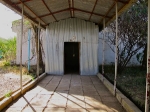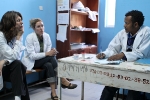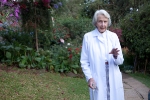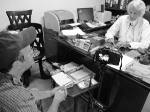Chapter One
‘You want a picture?’ he asked as we drove to the edge of the desolate canyon.
‘How about now? You don’t have camera?’
‘Later,’ I told him, ‘When we come back, when we return home.’
‘You sure? You sure you return home?’ he laughed.
That was a good question since I was wondering how this rusted jalopy, bouncing and speeding through curves, almost colliding with buses, was going to get us to Mota at all. Knuckles white, seizing a broken door handle, I watch as the broken speedometer oscillates anywhere from 0-120km while the gas gauge hoovers over empty.
‘We make the hospital in no time, maybe three hours.’
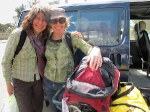 The only two story hotel in town is painted pink, Hotel Wubit, and sits midway along the dirt highway stretch of 240km, the original eastern through-way connecting Addis Ababa with the North. Asphalt has yet to see this part of the world.
The only two story hotel in town is painted pink, Hotel Wubit, and sits midway along the dirt highway stretch of 240km, the original eastern through-way connecting Addis Ababa with the North. Asphalt has yet to see this part of the world.
‘We are here, this is Mota!’ he smiles, pulling into the hotel parking lot, ‘Now we should have food.’ Inviting the driver to lunch, we collapse into wollen couches and share beyainatu, small portions of vegetarian food dumped over injera. We scoop potato, shiro, cold french fries, lentils and cabbage into our hungry mouths.
Road signs adorned in blue Amharic script line the road, we turn off towards the Hospital in search of our new home.
Blue and white paint coat the walls, colors of hospital and government. Only open for ten years, age prevails over the compound- a building has fallen, walls cracked, overgrown weeds and trash decorate the compound. An aluminum latrine sits downwind, but meandering the paths, one must be mindful of human scat.
Only in the last year has the hospital come alive- a water tank, the opening of an operating theater and a mini medical library. Water is pumped from the ground four mornings a week into the tank and keeps the plastic buckets in each ward filled. The small library houses a surprisingly large assortment of medical textbooks with two wooden desks filling the room and one dial-up computer with a lineup of staff waiting to check Facebook accounts.
Episodes of MASH come to mind passing through the aluminum doors into the operating ward. One room for minor procedures stays busy removing lumps and draining wounds. The main OR, reserved for gynecological emergencies, is open 1-2 times weekly. My visa and papers are stamped with such purpose, Dr. Philippa and I will become quite familiar with these quarters.
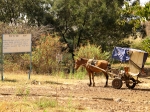 The morning of our first day, a daughter recovering from childbirth is carried home by her family, she rests atop a wooden bed strung with goat skin. At the same time, another daughter arrives, supported by the arms of her father and husband. Her pregnancy is full term, but her labor has stalled. Abraham*, a quiet, unassuming midwife, his second year working at the hospital quickly recognizes her distress- a ruptured uterus, the baby has lost its heart beat.
The morning of our first day, a daughter recovering from childbirth is carried home by her family, she rests atop a wooden bed strung with goat skin. At the same time, another daughter arrives, supported by the arms of her father and husband. Her pregnancy is full term, but her labor has stalled. Abraham*, a quiet, unassuming midwife, his second year working at the hospital quickly recognizes her distress- a ruptured uterus, the baby has lost its heart beat.
To the untrained eye, her stomach bulges on top and bottom, a valley between- twins, a mass, a fibroid tumor? Instead, Abraham teaches us, it is the sign of a ruptured uterus bulging atop and the dead baby bulging below. ‘The mother will die if she is not operated on immediately.‘
This is why we have come, this is the purpose of the Foundation, to train local medical doctors to perform emergency obstetrical services.
We are here to teach, but we have much to learn.
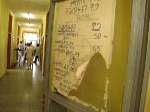 The story is complex, these young women are often malnourished and under developed. Their pelvis is small, creating a problem for childbirth. The nurse midwives, three females and four males, are incredible talented at using their hearts and hands delivering even the most difficult of births. But their magic ends once a baby becomes stuck in the birth canal, the mother’s survival precedes the baby’s. A Cesarean Section vs. removal of the fetus through the vagina. There are no perfect solutions.
The story is complex, these young women are often malnourished and under developed. Their pelvis is small, creating a problem for childbirth. The nurse midwives, three females and four males, are incredible talented at using their hearts and hands delivering even the most difficult of births. But their magic ends once a baby becomes stuck in the birth canal, the mother’s survival precedes the baby’s. A Cesarean Section vs. removal of the fetus through the vagina. There are no perfect solutions.
*Names have been changed.
[smooth=id:37]
to be continued…
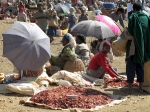 It is market day and the streets are full of donkey carts and barefoot pilgrims wrapped in their white gabi’s, driving their wares to the square. We buy potatoes, cabbage, beets, kale, onions, garlic, eggs and a chicken. Darlene named her Doro Wat, which is the national dish of Ethiopia, a spicy chicken stew. Philippa declared him a rooster and Joni sat on our patio and entertained the hospital staff with her arsenal of barnyard animal calls, drawing not only the rooster, but the sheep grazing in our yard. Yamatan prepared the bird for us, after I crawled into a shrub to retrieve the hobbling fowl as he made his break for it. We added pasta and spices and stewed him up in a pot we also bought from the market for just such an occasion.
It is market day and the streets are full of donkey carts and barefoot pilgrims wrapped in their white gabi’s, driving their wares to the square. We buy potatoes, cabbage, beets, kale, onions, garlic, eggs and a chicken. Darlene named her Doro Wat, which is the national dish of Ethiopia, a spicy chicken stew. Philippa declared him a rooster and Joni sat on our patio and entertained the hospital staff with her arsenal of barnyard animal calls, drawing not only the rooster, but the sheep grazing in our yard. Yamatan prepared the bird for us, after I crawled into a shrub to retrieve the hobbling fowl as he made his break for it. We added pasta and spices and stewed him up in a pot we also bought from the market for just such an occasion.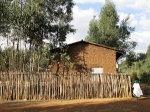 On the way home we took my favorite street, past the mosque and imams house, and like a child I peered thru the slotted wooden fence to the large golden wheat fields that makes up the eucalyptus lined yard. The men in the field across from ourhouse sift teff from hay and drive their cattle in circles to mix it up. Donkeys bray from somewhere out of sight and children run the dirt packed avenues with homemade pinwheels spinning in the wind. The hospital was quiet with two new births, the sun was present and ready as always.
On the way home we took my favorite street, past the mosque and imams house, and like a child I peered thru the slotted wooden fence to the large golden wheat fields that makes up the eucalyptus lined yard. The men in the field across from ourhouse sift teff from hay and drive their cattle in circles to mix it up. Donkeys bray from somewhere out of sight and children run the dirt packed avenues with homemade pinwheels spinning in the wind. The hospital was quiet with two new births, the sun was present and ready as always.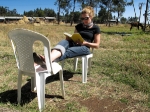 Darlene spreads across the chairs in the yard, dark glasses on, reading a novel as the heat of the afternoon soaks her clothes with warmth. Our pails are full of water, as today is a water day. At the stadium, the hospital futbol team tied in a tough match and Manchester United, the town favorite, won on the tele. It seems the perfect day.
Darlene spreads across the chairs in the yard, dark glasses on, reading a novel as the heat of the afternoon soaks her clothes with warmth. Our pails are full of water, as today is a water day. At the stadium, the hospital futbol team tied in a tough match and Manchester United, the town favorite, won on the tele. It seems the perfect day.
